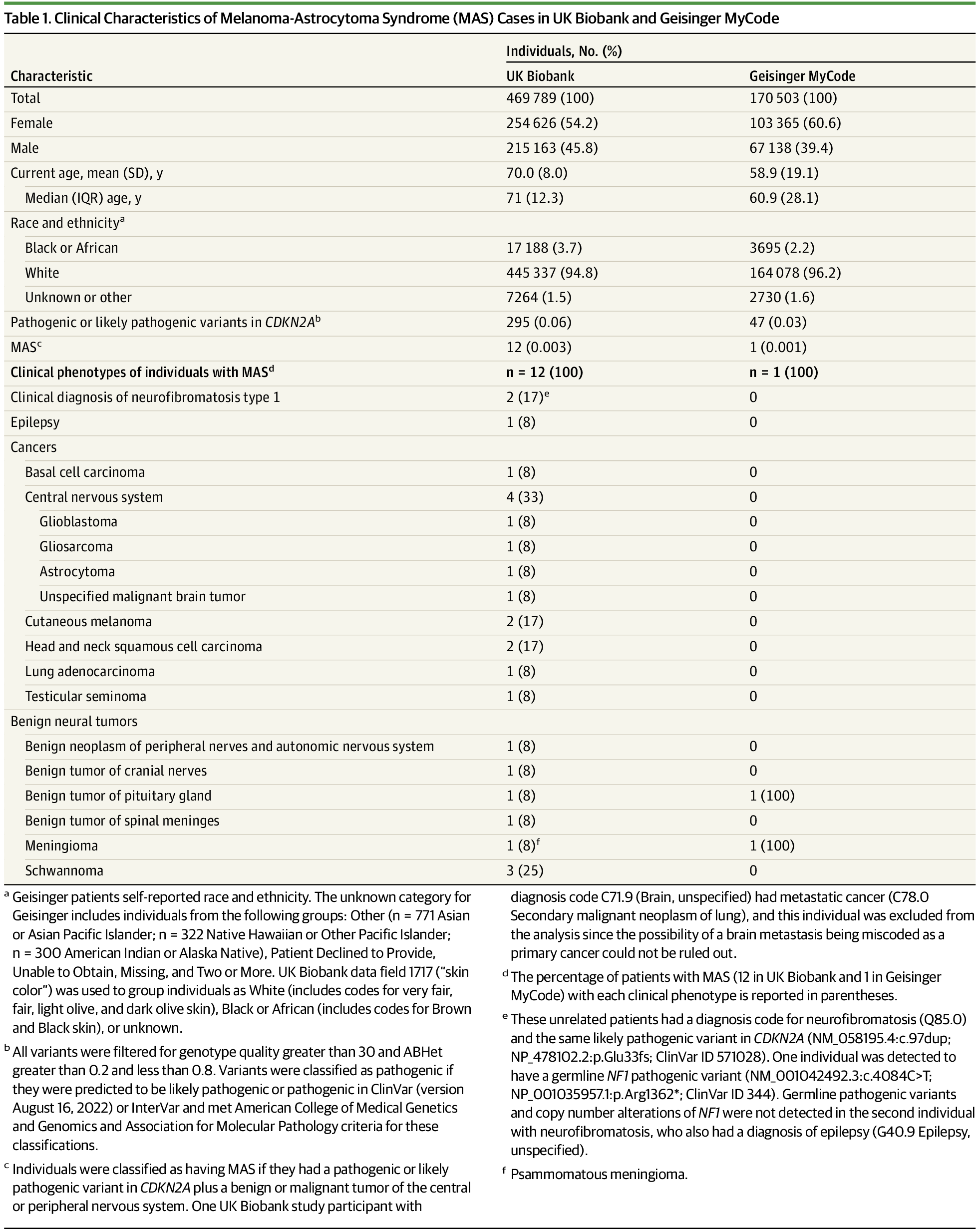Cancer and neoplasms
Prevalence and Tumors of CDKN2A-Related Melanoma-Astrocytoma Syndrome
Key Points
Question
What is the prevalence and tumor spectrum of CDKN2A-related melanoma-astrocytoma syndrome?
Findings
In this cohort study of 640 292 individuals in 2 population genomic databases, melanoma-astrocytoma syndrome prevalence ranged from 1 in 170 503 to 1 in 39 149, and patients had a diverse spectrum of neural and nonneural tumors. Multiple patients had clinical diagnoses of neurofibromatosis type 1 without genetic alterations of the NF1 gene.
Meaning
This study estimates prevalence and describes the tumor types of melanoma-astrocytoma syndrome, although additional studies are needed in genetically diverse populations to further define population prevalence and the spectrum of skin and nonskin phenotypes.
Importance
Knowledge about the prevalence and tumor types of CDKN2A-related melanoma-astrocytoma syndrome (MAS) is limited and could improve disease recognition.
Objective
To estimate the prevalence and describe the tumor types of MAS.
Design, Setting, and Participants
This retrospective cohort study analyzed all available MAS cases from medical centers in the US (2 sites) and Europe (2 sites) and from biomedical population genomic databases (UK Biobank [United Kingdom], Geisinger MyCode [US]) between January 1, 1976, and December 31, 2020. Patients with MAS with CDKN2A germline pathogenic variants and 1 or more neural tumors were included. Data were analyzed from June 1, 2022, to January 31, 2023.
Main Outcomes and Measures
Disease prevalence and tumor frequency.
Results
Prevalence of MAS ranged from 1 in 170 503 (n = 1 case; 95% CI, 1:30 098-1:965 887) in Geisinger MyCode (n = 170 503; mean [SD] age, 58.9 [19.1] years; 60.6% women; 96.2% White) to 1 in 39 149 (n = 12 cases; 95% CI, 1:22 396-1:68 434) in UK Biobank (n = 469 789; mean [SD] age, 70.0 [8.0] years; 54.2% women; 94.8% White). Among UK Biobank patients with MAS (n = 12) identified using an unbiased genomic ascertainment approach, brain neoplasms (4 of 12, 33%; 1 glioblastoma, 1 gliosarcoma, 1 astrocytoma, 1 unspecified type) and schwannomas (3 of 12, 25%) were the most common malignant and benign neural tumors, while cutaneous melanoma (2 of 12, 17%) and head and neck squamous cell carcinoma (2 of 12, 17%) were the most common nonneural malignant neoplasms. In a separate case series of 14 patients with MAS from the US and Europe, brain neoplasms (4 of 14, 29%; 2 glioblastomas, 2 unspecified type) and malignant peripheral nerve sheath tumor (2 of 14, 14%) were the most common neural cancers, while cutaneous melanoma (4 of 14, 29%) and sarcomas (2 of 14, 14%; 1 liposarcoma, 1 unspecified type) were the most common nonneural cancers. Cutaneous neurofibromas (7 of 14, 50%) and schwannomas (2 of 14, 14%) were also common. In 1 US family, a father and son with MAS had clinical diagnoses of neurofibromatosis type 1 (NF1). Genetic testing of the son detected a pathogenic CDKN2A splicing variant (c.151-1G>C) and was negative for NF1 genetic alterations. In UK Biobank, 2 in 150 (1.3%) individuals with clinical NF1 diagnoses had likely pathogenic variants in CDKN2A, including 1 individual with no detected variants in the NF1 gene.
Conclusions and Relevance
This cohort study estimates the prevalence and describes the tumors of MAS. Additional studies are needed in genetically diverse populations to further define population prevalence and disease phenotypes.

